A Step-by-Step Guide to Greenhouse Gardening in Winter
Winter doesn’t have to halt your gardening ambitions. With a greenhouse, you can cultivate plants year-round, even when temperatures drop. Growing during winter allows you to enjoy fresh produce and vibrant plants at a time when outdoor gardens lie dormant.
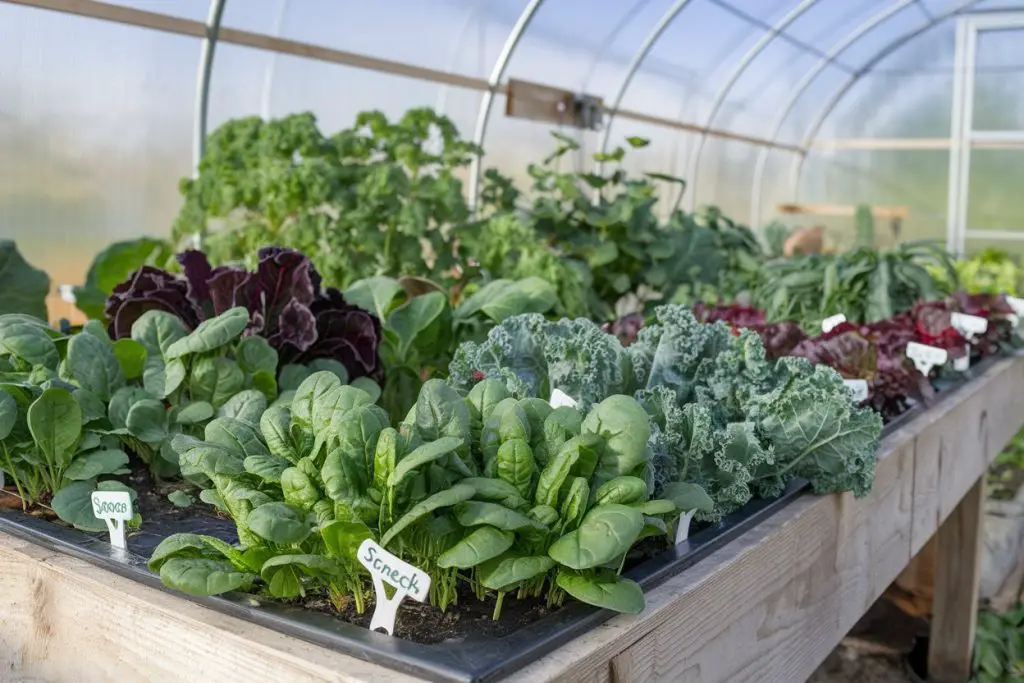
Benefits of Winter Greenhouse Gardening
Having a greenhouse means accessing fresh vegetables and herbs throughout the cold months. It extends the growing season for certain plants, providing flavors and nutrients often missing in winter diets. Tending to your greenhouse offers a rewarding hobby that keeps you connected to nature all year.
Overview of the Guide
This guide presents detailed steps to help both beginners and seasoned gardeners navigate the unique challenges of winter greenhouse gardening. Each section breaks down essential tasks, from preparing your greenhouse to selecting suitable crops. By the end, you’ll have the knowledge to maintain a thriving greenhouse throughout winter.
Step 1: Preparing Your Greenhouse for Winter
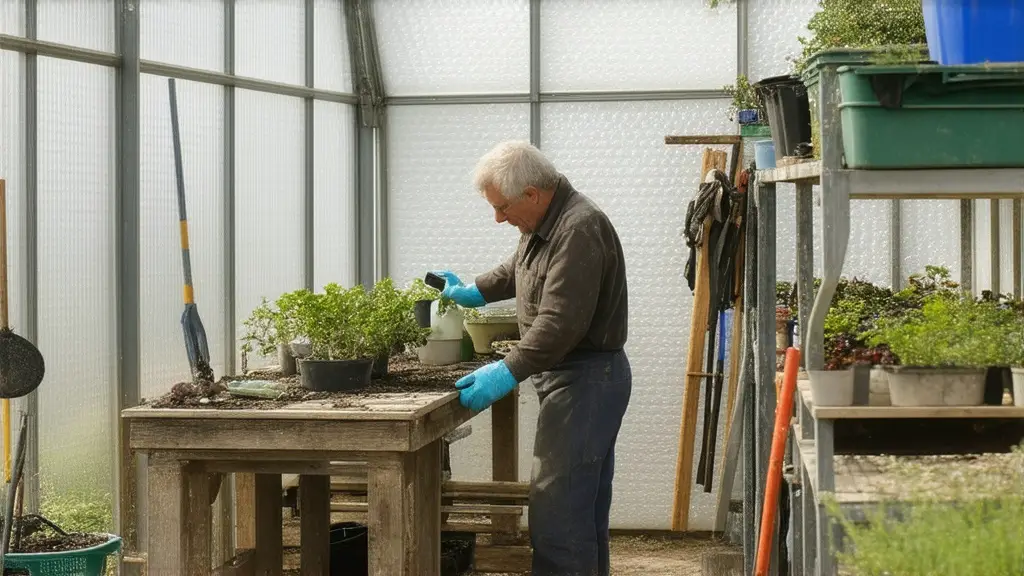
Cleaning and Disinfecting
Before winter sets in, it’s crucial to clean and disinfect your greenhouse. Start by removing leftover plants, weeds, and debris from the previous season. Clearing out these materials helps prevent pests and diseases from taking hold. Use a mild disinfectant to sanitize surfaces, including benches, tools, and interior walls. This reduces the risk of pathogens that could harm your winter crops.
Inspecting the Structure
A thorough inspection of the greenhouse ensures it can withstand winter weather. Check for cracks, gaps, or damage in the glazing and framework. Pay attention to seals around doors and vents, making sure they close tightly. Repairing these issues prevents heat loss and keeps the environment stable.
Enhancing Insulation
Improving insulation is key to maintaining warmth. Consider applying bubble wrap or thermal screens to the glazing to reduce heat loss. Seal remaining gaps with weather stripping or caulk. These steps help retain heat, making your greenhouse more energy-efficient and your plants more comfortable.
Optimizing Layout for Winter
Rearranging your greenhouse layout can maximize light and space during winter. Place taller plants toward the back or sides, ensuring they don’t block light from smaller plants. Organize your workspace to accommodate winter tasks, keeping tools and supplies within easy reach. This setup enhances efficiency and makes daily maintenance more manageable.
Step 2: Installing and Managing Heating Systems
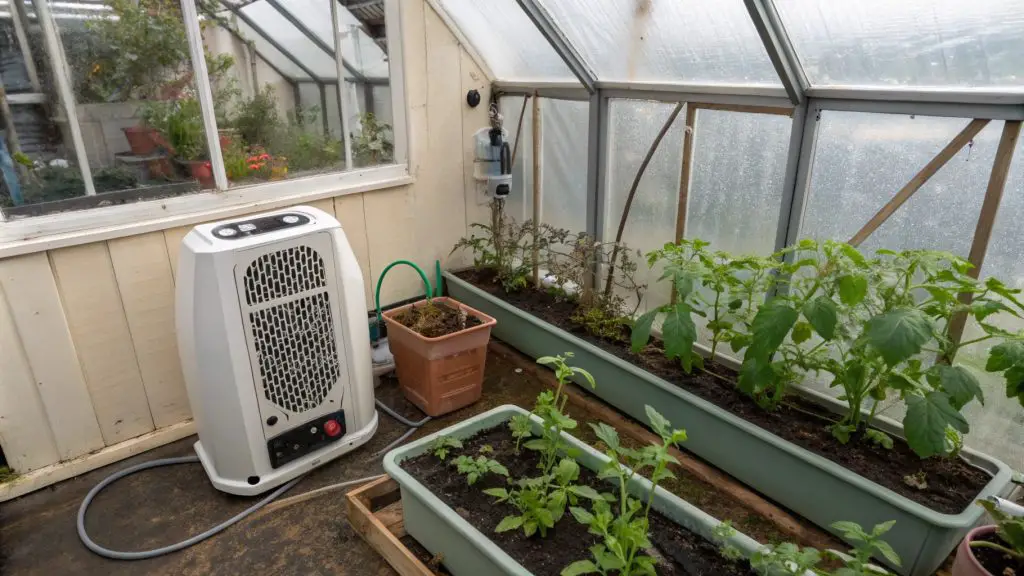
Assessing Heating Needs
Understanding your greenhouse’s heating requirements is essential. Begin by identifying the optimal temperature ranges for your chosen winter crops. Most cool-season vegetables thrive between 45°F and 75°F. Calculate your greenhouse’s heat loss by considering factors like size, insulation, and local climate. This information helps in choosing the most suitable heating method.
Choosing a Heating Method
Several heating options are available for greenhouses.
Electric Heaters
Electric heaters are popular due to ease of use and installation. They offer precise temperature control and are generally safe. However, they can be costly to operate, especially in larger spaces.
Gas Heaters
Gas heaters provide strong heating power suitable for bigger greenhouses. They require proper ventilation to prevent harmful gases from accumulating. Professional installation ensures safety and optimal performance.
Passive Solar Heating
Utilizing passive solar heating methods can reduce energy costs. Incorporate thermal mass materials like water barrels or stone flooring, which absorb heat during the day and release it at night. This approach harnesses solar energy to maintain warmer temperatures without additional fuel.
Installing Heaters
Proper placement of heaters is vital for even heat distribution. Position heaters where they won’t directly touch plants but can circulate warm air effectively. Integrate thermostats and timers to maintain consistent temperatures and reduce energy consumption when heating isn’t necessary.
Safety Measures
Safety should always be a priority. Ensure that heating equipment is installed correctly and that flammable materials are kept away. For gas heaters, adequate ventilation prevents the accumulation of carbon monoxide. Regularly check and maintain heating systems to avoid hazards.
Step 3: Enhancing Light Availability
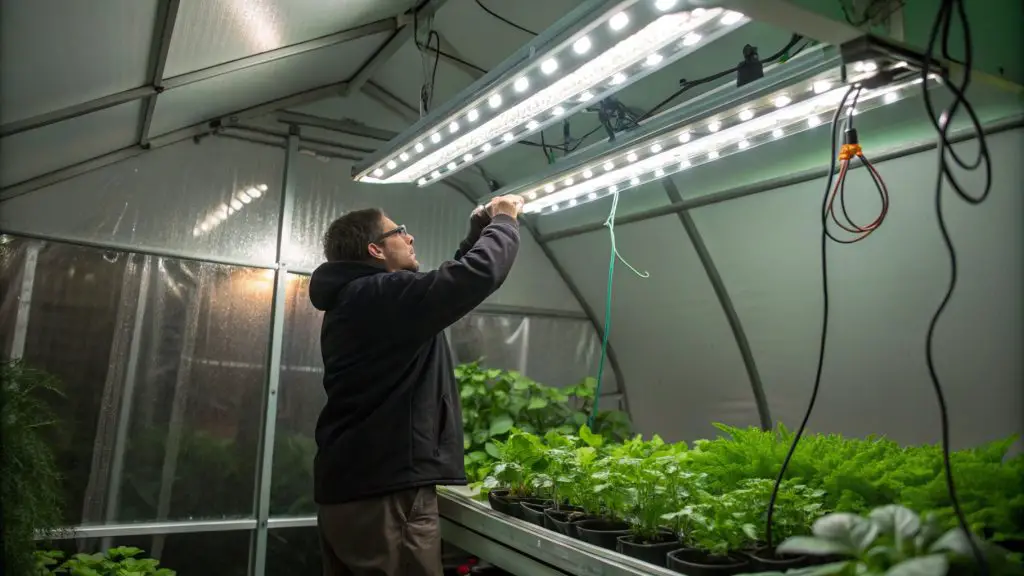
Maximizing Natural Light
In winter, natural light is limited. To make the most of it, keep the greenhouse’s glazing clean. Dirt and grime can block significant amounts of sunlight. Adding reflective surfaces inside, such as white-painted walls or reflective mulch, helps bounce light onto plants. Position plants to receive maximum possible sunlight throughout the day.
Supplemental Lighting Options
When natural light isn’t sufficient, supplemental lighting becomes necessary.
LED Grow Lights
LED grow lights are energy-efficient and offer customizable light spectrums suited for different plants. They produce less heat, reducing the risk of burning foliage, and have a long lifespan.
Fluorescent Lights
Fluorescent lights are effective for seedlings and leafy greens. They are affordable and consume less energy than traditional bulbs. However, they may not provide enough light intensity for fruiting plants.
Installation Tips
Place lights at the appropriate distance from plants, typically 6 to 12 inches for fluorescent lights and according to manufacturer recommendations for LEDs. Use timers to mimic natural daylight patterns, usually aiming for 12 to 16 hours of light per day, depending on crop needs.
Balancing Light and Darkness
Understanding the photoperiods of plants is important. Some require periods of darkness to trigger flowering or fruiting. Avoid overexposure to artificial light, which can disrupt these natural cycles. Ensure lighting schedules align with the specific requirements of each plant species.
Step 4: Selecting Suitable Winter Crops
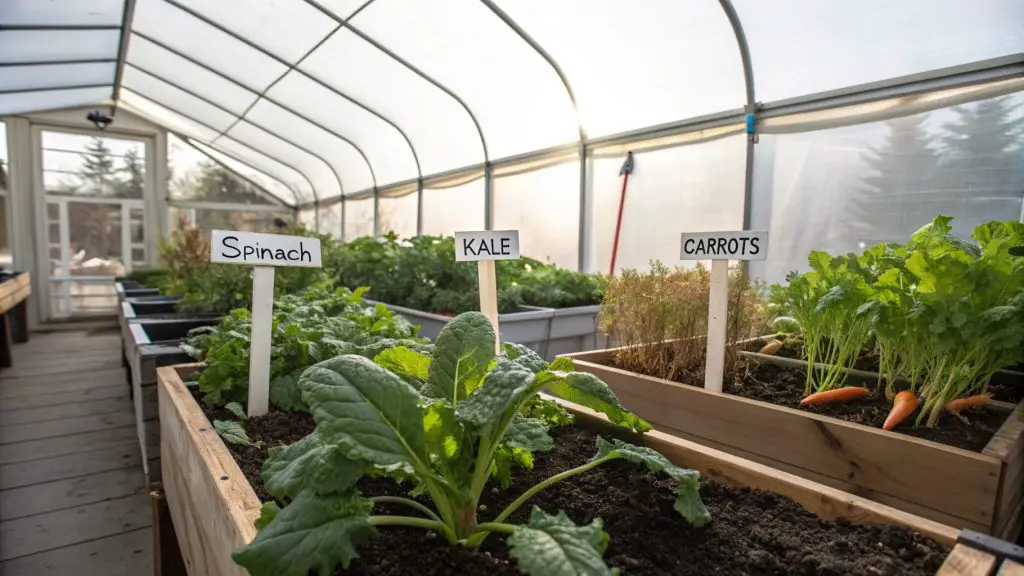
Cold-Hardy Vegetables
Choosing the right crops is key to winter gardening success. Leafy greens like spinach, kale, and lettuce thrive in cooler temperatures. They grow quickly and tolerate light frosts. Root vegetables such as carrots, radishes, and beets are excellent choices. They develop well in the consistent temperatures of a greenhouse.
Winter-Flowering Plants
Adding winter-flowering plants like pansies, cyclamen, and hellebores brings color to the greenhouse. These plants are adapted to cooler climates and brighten the space during darker months.
Herbs and Perennials
Growing herbs like rosemary, thyme, and mint provides fresh flavors for winter cooking. Many perennials can overwinter in a greenhouse, allowing you to maintain mature plants year after year.
Planning Crop Rotation
Implementing crop rotation helps prevent soil depletion and reduces the buildup of pests and diseases. Plan planting schedules so different plant families follow each other in the same space. This practice promotes healthier soil and better yields over time.
Step 5: Soil and Potting Mix Preparation
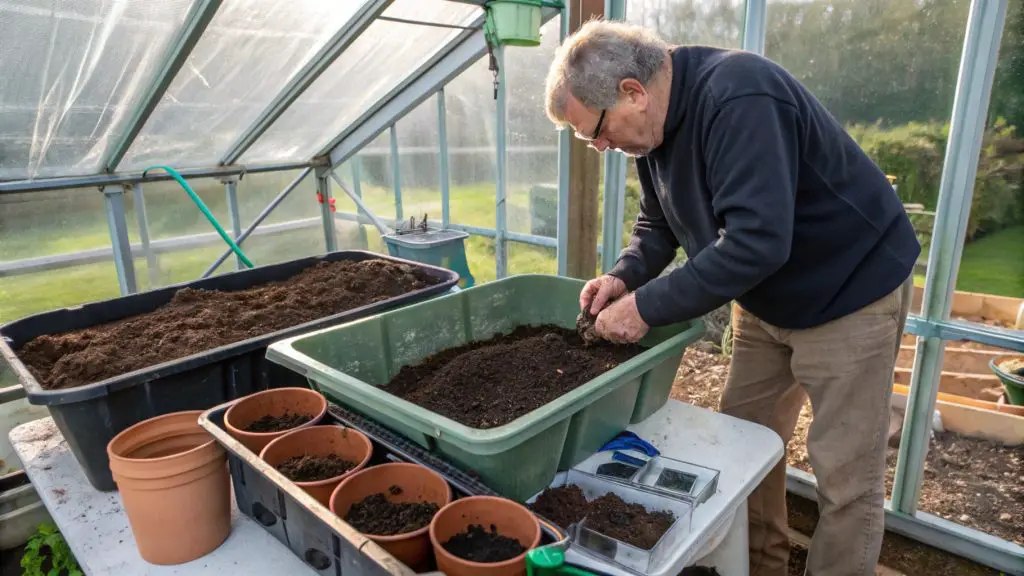
Testing and Amending Soil
Healthy soil is the foundation of successful gardening. Start by testing pH levels and nutrient content. Most vegetables prefer a slightly acidic to neutral pH between 6.0 and 7.0. Amend soil by adding compost or organic matter to improve fertility and structure.
Preparing Potting Mixes
When using containers, create a well-draining, nutrient-rich potting mix. A basic recipe includes equal parts peat moss or coir, perlite or vermiculite, and compost. Sterilizing the mix by heating it in an oven can eliminate pathogens and pests.
Choosing Containers and Beds
Decide between raised beds and pots based on your greenhouse layout. Raised beds offer better drainage and can be easier on your back. Ensure all containers have adequate drainage holes to prevent waterlogging.
Mulching Techniques
Apply mulch to conserve soil moisture and regulate temperature. Organic mulches like straw or shredded leaves decompose over time, adding nutrients to the soil. Mulching also suppresses weeds, reducing competition for resources.
Step 6: Planting Techniques for Winter
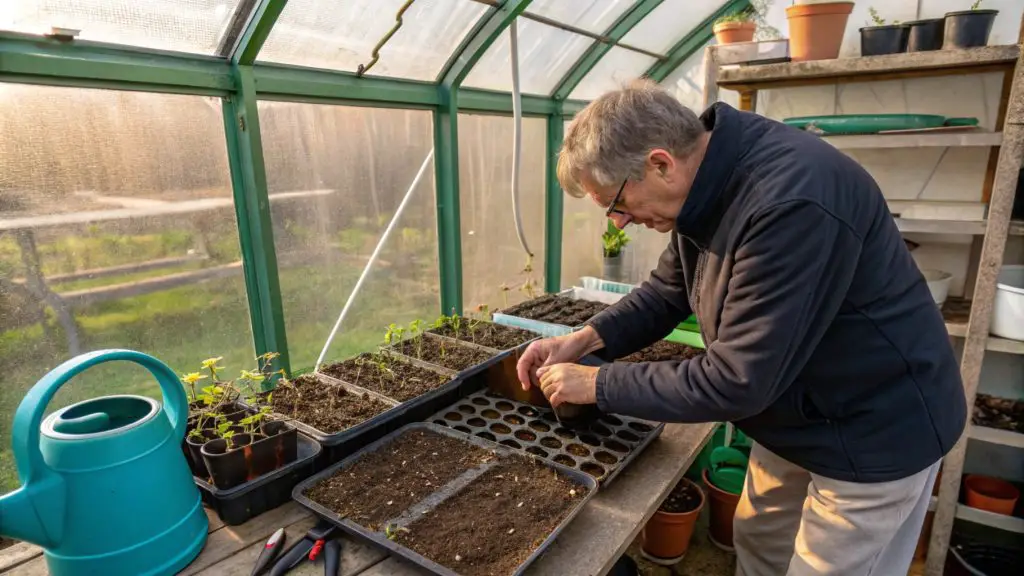
Sowing Seeds
Timing is crucial when sowing seeds in winter. Use seed packets to determine appropriate planting dates. To encourage germination, consider using heat mats under seed trays, providing consistent warmth. Keep soil moist but not soggy to prevent rot.
Transplanting Seedlings
When seedlings develop true leaves, they are ready for transplanting. Harden off plants by gradually exposing them to the greenhouse environment over several days. This reduces transplant shock and helps them adjust to new conditions.
Spacing and Depth Guidelines
Follow recommended spacing guidelines to ensure plants have room for growth and airflow. Overcrowding can lead to diseases due to poor air circulation. Plant seeds and transplants at the correct depth, as specified for each species, to promote healthy root development.
Labeling and Record-Keeping
Keep track of plantings by labeling each row or container with the variety and planting date. Maintaining a gardening journal helps monitor progress and informs future planting decisions.
Step 7: Watering and Humidity Control

Adjusting Watering Practices
Plants require less water in winter due to reduced evaporation and slower growth rates. Water when the top inch of soil feels dry. It’s best to water in the morning, allowing excess moisture to evaporate and reducing the risk of fungal diseases.
Preventing Overwatering
Overwatering is a common problem in winter. Signs include yellowing leaves and wilting despite moist soil. Use a moisture meter to accurately assess soil levels. Ensure containers have proper drainage to avoid waterlogged roots.
Managing Humidity Levels
Maintaining ideal humidity levels helps prevent diseases. Most winter crops prefer humidity between 50% and 70%. If humidity is too high, ventilate the greenhouse to reduce moisture. Use water trays or misting to increase humidity if levels are too low.
Irrigation Systems
Consider installing a drip irrigation system for consistent and efficient watering. Automated systems can be set on timers, ensuring plants receive water even when you’re not around. Drip irrigation reduces water waste and minimizes wet foliage, which can lead to disease.
Step 8: Ventilation and Airflow Management
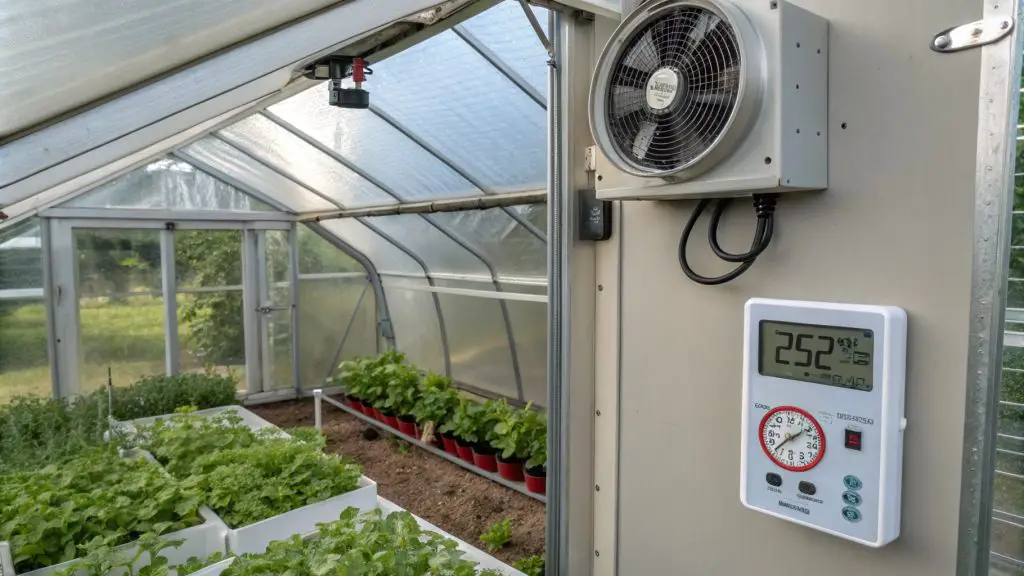
Importance of Ventilation
Proper ventilation is essential to prevent mold, mildew, and overheating. Even in winter, greenhouses can become too warm on sunny days. Ventilation helps regulate temperature and humidity, creating a healthier environment for plants.
Ventilation Methods
Use manual methods like opening windows and doors during warmer periods to allow fresh air in. Installing exhaust fans and vents provides more controlled ventilation. Automated vent openers adjust vents based on temperature changes.
Circulation Fans
Adding circulation fans helps distribute air evenly throughout the greenhouse. This reduces cold spots and prevents stagnant air, which can harbor diseases. Fans should run continuously or on a timer to maintain consistent airflow.
Monitoring Environmental Conditions
Regularly check temperature and humidity with thermometers and hygrometers. Recording this data allows adjustments as needed. Keeping a log helps identify patterns or issues over time.
Step 9: Pest and Disease Control

Common Winter Pests
Even in winter, pests like aphids, whiteflies, and spider mites can affect plants. Inspect regularly for signs of infestation, such as distorted leaves or visible insects.
Organic Pest Control Methods
Implementing organic pest control protects plants without harmful chemicals. Introduce beneficial insects like ladybugs or predatory mites that prey on pests. Homemade sprays using ingredients like neem oil or insecticidal soap can be effective.
Disease Prevention Strategies
Prevent diseases by practicing good sanitation. Remove dead or diseased plant material promptly. Use disease-resistant varieties when possible. Crop rotation and proper spacing reduce the likelihood of disease spread.
Integrated Pest Management (IPM)
Adopt an Integrated Pest Management approach that combines cultural, biological, and mechanical controls. Monitor pest populations and use chemical pesticides as a last resort. This strategy minimizes environmental impact and promotes a balanced ecosystem.
Step 10: Harvesting and Ongoing Maintenance
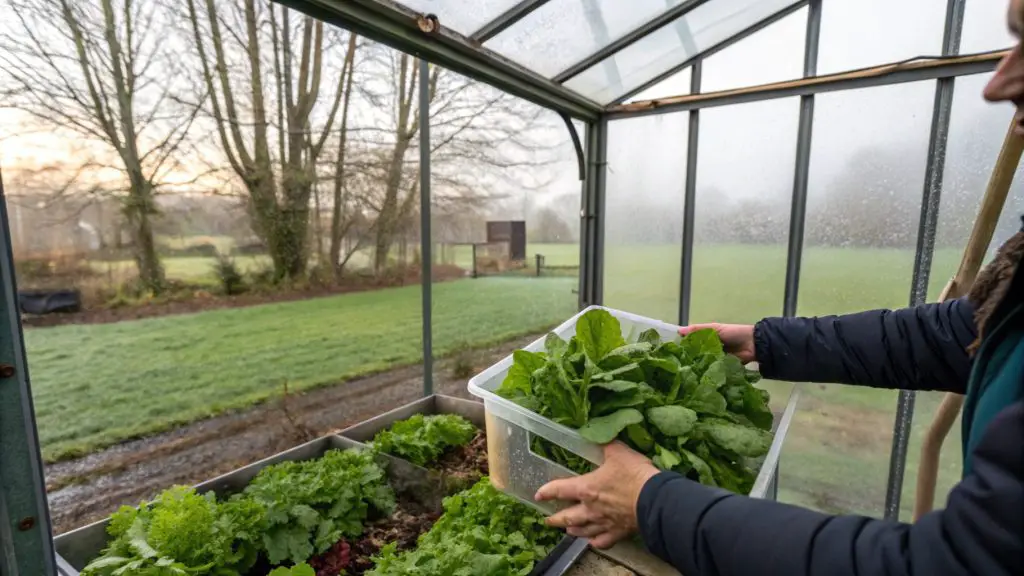
Harvesting Techniques
Harvest crops at their peak for the best flavor and nutritional value. Use clean, sharp tools to cut vegetables and herbs, reducing plant stress. For cut-and-come-again plants like lettuce, harvest outer leaves so the plant continues to produce new growth.
Succession Planting
Plan succession planting to ensure a continuous harvest. This involves planting new seeds or transplants at regular intervals. Staggered planting schedules help avoid periods without fresh produce.
Pruning and Plant Care
Regularly prune to remove dead or diseased foliage. This encourages healthy growth and prevents the spread of disease. Support taller plants with stakes or trellises to keep them upright and reduce breakage.
Fertilizing During Winter
While plants need fewer nutrients in winter, occasional feeding may be necessary. Use a balanced, water-soluble fertilizer at half strength to avoid over-fertilization. Always follow manufacturer’s instructions to prevent nutrient burn.
Step 11: Troubleshooting Common Issues
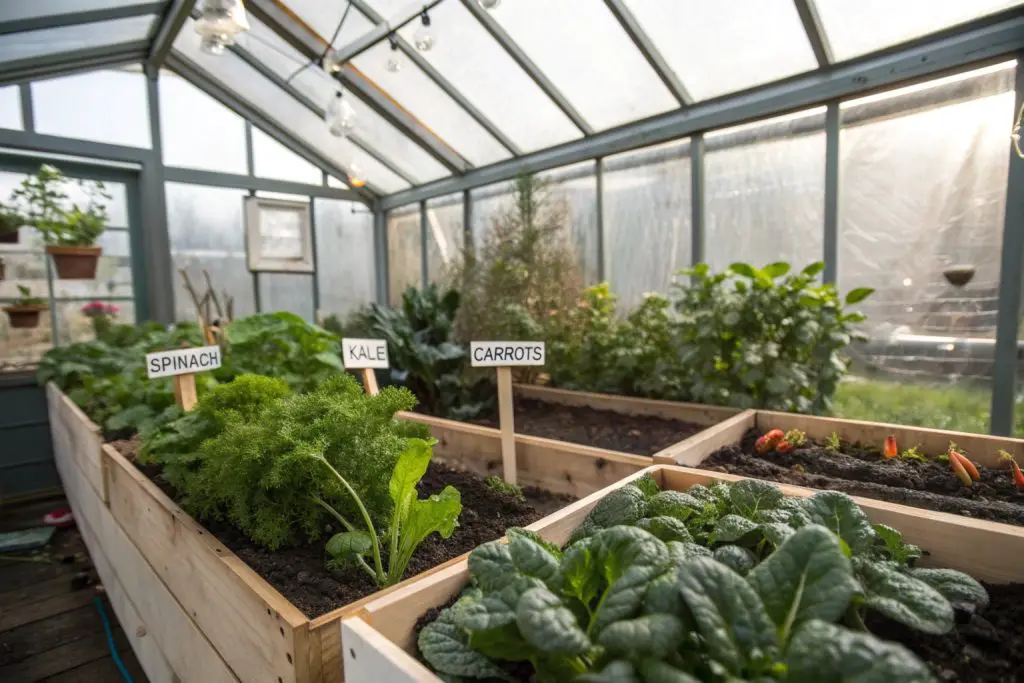
Temperature Fluctuations
Sudden temperature changes can stress plants. Insulate the greenhouse adequately and use thermal mass materials to stabilize temperatures. Monitor weather forecasts to prepare for extreme conditions.
Light Deficiency
If plants show signs of light deficiency, such as leggy growth or pale leaves, adjust supplemental lighting. Ensure lights provide the appropriate spectrum and intensity for crops.
Overcoming Slow Growth
Slow growth can result from inadequate nutrients or root problems. Check that plants aren’t root-bound and soil has sufficient nutrients. Amend soil or repot as needed.
Dealing with Wilting or Yellowing Plants
Wilting or yellowing can indicate water issues or disease. Confirm watering practices are appropriate and drainage is adequate. Inspect roots for signs of rot and treat diseases promptly.
Its Time to Get Ready
Winter greenhouse gardening offers the satisfaction of nurturing plants through cold months. It provides fresh produce and a green space that lifts spirits during gloomy days. The effort invested yields tangible rewards in both harvest and personal fulfillment.
Next Steps
Whether new to greenhouse gardening or expanding skills, winter offers unique opportunities for growth. Continue learning and experimenting with different crops and techniques. Sharing experiences with fellow gardeners builds a supportive community.
If you need more help, consider joining local gardening groups. Many communities offer workshops and events that provide valuable insights and hands-on experience.
